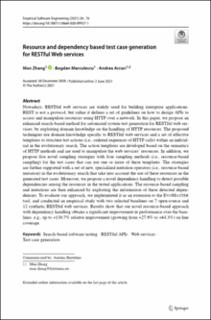Resource and dependency based test case generation for RESTful Web services
Peer reviewed, Journal article
Published version
Permanent lenke
https://hdl.handle.net/11250/2991533Utgivelsesdato
2021Metadata
Vis full innførselSamlinger
Originalversjon
Empirical Software Engineering. 2021, 26 . https://doi.org/10.1007/s10664-020-09937-1Sammendrag
Nowadays, RESTful web services are widely used for building enterprise applications. REST is not a protocol, but rather it defines a set of guidelines on how to design APIs to access and manipulate resources using HTTP over a network. In this paper, we propose an enhanced search-based method for automated system test generation for RESTful web services, by exploiting domain knowledge on the handling of HTTP resources. The proposed techniques use domain knowledge specific to RESTful web services and a set of effective templates to structure test actions (i.e., ordered sequences of HTTP calls) within an individual in the evolutionary search. The action templates are developed based on the semantics of HTTP methods and are used to manipulate the web services’ resources. In addition, we propose five novel sampling strategies with four sampling methods (i.e., resource-based sampling) for the test cases that can use one or more of these templates. The strategies are further supported with a set of new, specialized mutation operators (i.e., resource-based mutation) in the evolutionary search that take into account the use of these resources in the generated test cases. Moreover, we propose a novel dependency handling to detect possible dependencies among the resources in the tested applications. The resource-based sampling and mutations are then enhanced by exploiting the information of these detected dependencies. To evaluate our approach, we implemented it as an extension to the EVOMASTER tool, and conducted an empirical study with two selected baselines on 7 open-source and 12 synthetic RESTful web services. Results show that our novel resource-based approach with dependency handling obtains a significant improvement in performance over the baselines, e.g., up to +130.7% relative improvement (growing from +27.9% to +64.3%) on line coverage.

